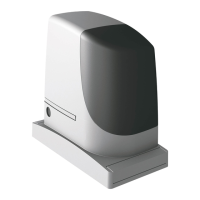12
EN
9
WHATTODOIF…(Troubleshootingguide)
9.1 - DIAGNOSTICS
Some devices are display messages to identify their status and faults.
The following paragraphs describe the messages available with the different types of device.
9.2 - Troubleshooting
Table 17 gives some troubleshooting procedures, for use during installation and in case of malfunctions.
TABLE 17
Troubleshooting
01. The radio transmitter does not control the gate and the
led on the transmitter does not light up
Check to see if the transmitter batteries are exhausted, if necessary replace them
02. The radio transmitter does not control the gate but the
led on the transmitter lights up
Check to see if the transmitter has been memorised correctly in the radio receiver
03. No manoeuvre starts and the “BlueBus” led does not
ash
Check that RUN is powered off the mains.
Check to see if fuses F1, F2 or F3 are blown; if necessary, identify the reason for the failure
and then replace the fuses with others having the same current rating and characteristics
04. Nomanoeuvrestartsandtheasherisoff Make sure that the command is actually received. If the command reaches the STEP-BY-
STEP input, the corresponding “STEP-BY-STEP” led must light up; if you are using the radio
transmitter,the“BlueBus”ledmustmaketwoquickashes.
05. No manoeuvre starts and the flasher flashes a few
times
Counttheashesandcheckthecorrespondingvalueintable19
06. The manoeuvre starts but it is immediately followed by
a reverse run
The selected force could be too low for this type of gate. Check to see whether there are any
obstacles; if necessary increase the force
07. Themanoeuvreiscarriedoutbuttheasherdoesnot
work
Makesurethatthereisvoltageontheasher’sFLASHterminalduringthemanoeuvre(being
intermittent, the voltage value is not important: approximately 10-30Vdc); if there is voltage,
the problem is due to the lamp; in this case replace the lamp with one having the same
characteristics;ifthereisnovoltage,theremayhavebeenanoverloadontheFLASHoutput.
Check that the cable has not short-circuited.
08. The manoeuvre is carried out but the Open Gate Indi-
cator does not work
Check the type of function programmed for the S.C.A. output (Table 8)
When the light should be on, check there is voltage on the S.C.A. terminal (approximately
24Vdc). If there is voltage, then the problem will have been caused by the light, which will
have to be replaced with one with the same characteristics. If there is no voltage, there may
have been an overload on the S.C.A. output. Check that the cable has not short-circuited.
9.3 - Malfunctions archive
RUN can display any faults that have occurred in the last 8 manoeuvres, for example interruption of a manoeuvre due to activation of a photocell or sensitive edge.
To check the list of faults, proceed as for Table 18:
TABLE 18
Malfunctions log
01. Press and hold the “Set” key for about 3 seconds;
02. Release “Set” when led L1startsashing;
03.
Press key “s” or “t”tomovetheashingledontoL8,i.e.the“inputled”fortheMalfunctionsLogparameter;
04. Press and hold down “Set” throughout steps 5 and 6;
05. Wait approx. 3s after which the leds corresponding to the manoeuvres subject to faults will light up. Led L1 indicates the result of the last manoeuvre
and L8 indicates the result of the 8th manoeuvre. If the led is on, this means that a defect occurred during that manoeuvre; if the led is off, this means
that no defect occurred during that manoeuvre;
06.
Press keys “s” and “t”toselecttherequiredmanoeuvre:thecorrespondingledashesthesamenumberoftimesasthosemadebytheasherafter
a defect (see table 19);
07. Release the “Set” key.
9.4 - Flasher signals
Ifyouconnectaashertothecontrolunit'sFLASHoutput(oraledasherprogrammedtoactasaasher),itwillashonceasecondduringmanoeuvres.Ifany
faultsarise,theasherwilldisplaywarningsignalswhichrepeattwicewitha1secondpausebetweenthem.ThesamesignalsaredisplayedbytheBlueBusled
andtheledasher.Table19describesthecausesandsolutionsforeachsignal.
TABLE 19
Signal Cause Solution
1ash
1 second pause
1ash
BlueBus error The BlueBus connected device check, run at the start of the manoeuvre,
does not match the devices memorised during device recognition. Some
faulty devices may be present; check and replace them as necessary.
2ashes
1 second pause
2ashes
Triggering of a photocell At the start of the manoeuvre, one or more photocells fail to give the en-
able signal; check for obstacles and whether the photocells are interfer-
ing with each other's IR.

